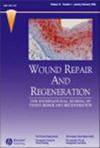Update of biomarkers to diagnose diabetic foot osteomyelitis: A meta‐analysis and systematic review
IF 3.8
3区 医学
Q2 CELL BIOLOGY
引用次数: 0
Abstract
The aim of this study was to evaluate the diagnostic characteristics of biomarker for diabetic foot osteomyelitis (DFO). We searched PubMed, Scopus, Embase and Medline for studies who report serological markers and DFO before December 2022. Studies must include at least one of the following diagnostic parameters for biomarkers: area under the curve, sensitivities, specificities, positive predictive value, negative predictive value. Two authors evaluated quality using the Quality Assessment of Diagnostic Accuracy Studies tool. We included 19 papers. In this systematic review, there were 2854 subjects with 2134 (74.8%) of those patients being included in the meta‐analysis. The most common biomarkers were erythrocyte sedimentation rate (ESR), C‐reactive protein (CRP) and procalcitonin (PCT). A meta‐analysis was then performed where data were evaluated with Forrest plots and receiver operating characteristic curves. The pooled sensitivity and specificity were 0.72 and 0.75 for PCT, 0.72 and 0.76 for CRP and 0.70 and 0.77 for ESR. Pooled area under the curves for ESR, CRP and PCT were 0.83, 0.77 and 0.71, respectfully. Average diagnostic odds ratios were 16.1 (range 3.6–55.4), 14.3 (range 2.7–48.7) and 6.7 (range 3.6–10.4) for ESR, CRP and PCT, respectfully. None of the biomarkers we evaluated could be rated as ‘outstanding’ to diagnose osteomyelitis. Based on the areas under the curve, ESR is an ‘excellent’ biomarker to detect osteomyelitis, and CRP and PCT are ‘acceptable’ biomarkers to diagnose osteomyelitis. Diagnostic odds ratios indicate that ESR, CRP and PCT are ‘good’ or ‘very good’ tools to identify osteomyelitis.诊断糖尿病足骨髓炎的生物标志物的更新:荟萃分析和系统综述
本研究旨在评估糖尿病足骨髓炎(DFO)生物标志物的诊断特征。我们在PubMed、Scopus、Embase和Medline上搜索了2022年12月之前报告血清学标记物和DFO的研究。研究必须至少包括以下一项生物标记物诊断参数:曲线下面积、敏感性、特异性、阳性预测值、阴性预测值。两位作者使用诊断准确性研究质量评估工具对研究质量进行了评估。我们共纳入了 19 篇论文。在这篇系统综述中,共有2854名受试者,其中2134名(74.8%)患者被纳入荟萃分析。最常见的生物标记物是红细胞沉降率(ESR)、C反应蛋白(CRP)和降钙素原(PCT)。然后进行了荟萃分析,利用福斯特图和接收器工作特征曲线对数据进行了评估。PCT 的集合敏感性和特异性分别为 0.72 和 0.75,CRP 为 0.72 和 0.76,ESR 为 0.70 和 0.77。血沉、CRP 和 PCT 的集合曲线下面积分别为 0.83、0.77 和 0.71。血沉、CRP 和 PCT 的平均诊断几率分别为 16.1(范围 3.6-55.4)、14.3(范围 2.7-48.7)和 6.7(范围 3.6-10.4)。在诊断骨髓炎方面,我们所评估的生物标志物中没有一个能被评为 "优秀"。根据曲线下面积,血沉是检测骨髓炎的 "优秀 "生物标志物,而 CRP 和 PCT 是诊断骨髓炎的 "可接受 "生物标志物。诊断几率比表明,血沉、CRP 和 PCT 是识别骨髓炎的 "良好 "或 "非常好 "的工具。
本文章由计算机程序翻译,如有差异,请以英文原文为准。
求助全文
约1分钟内获得全文
求助全文
来源期刊

Wound Repair and Regeneration
医学-皮肤病学
CiteScore
5.90
自引率
3.40%
发文量
71
审稿时长
6-12 weeks
期刊介绍:
Wound Repair and Regeneration provides extensive international coverage of cellular and molecular biology, connective tissue, and biological mediator studies in the field of tissue repair and regeneration and serves a diverse audience of surgeons, plastic surgeons, dermatologists, biochemists, cell biologists, and others.
Wound Repair and Regeneration is the official journal of The Wound Healing Society, The European Tissue Repair Society, The Japanese Society for Wound Healing, and The Australian Wound Management Association.
 求助内容:
求助内容: 应助结果提醒方式:
应助结果提醒方式:


